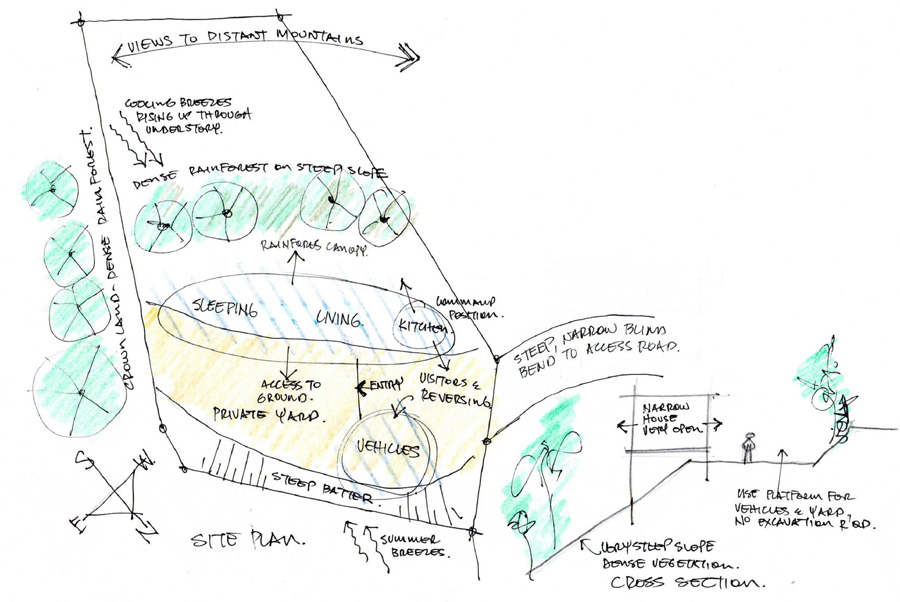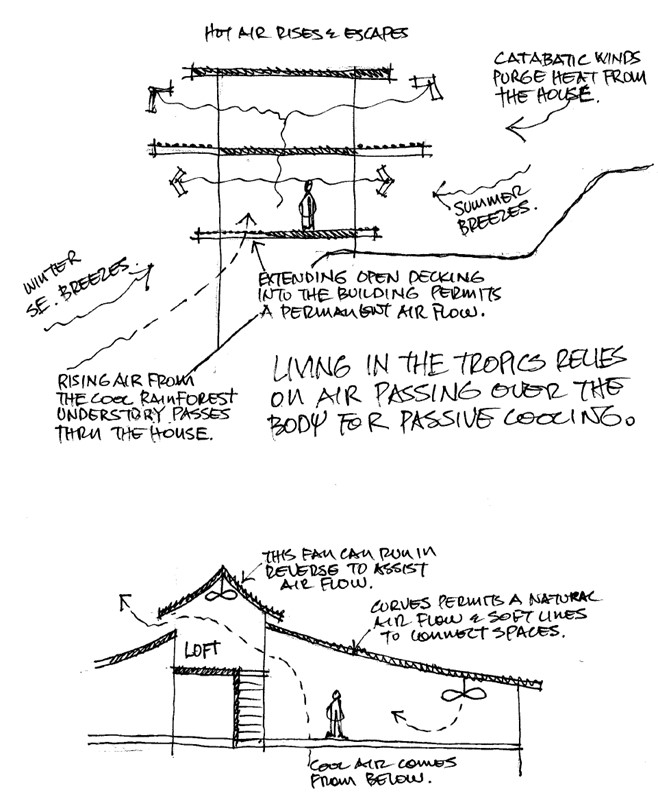Stack Close Residence
Residential - Materials

Key facts
A compact home with a long, narrow east west orientation with no wasted space and minimal maintenance
Natural cooling by pitching ceilings to promote a rising air flow and drawing cool air through gaps in the floor
Project Data
- Location: Redlynch, Cairns
- Year Completed: 2008
Overview
This was a difficult sloping site adjoining the rainforest that encouraged a ‘tread lightly on the earth principal’ (careful site works protect the environment and often costs less). Designing with light weight construction and a minimal flat platform ensured interaction with this spectacular rainforest site at all times.
The house is long and narrow which enabled the principals of passive tropical design and making the most of the natural features of the site. Recycled timbers were used extensively throughout the project and the unnecessary use of materials was taken seriously. Soffit lining, fascias, trims etc are all eliminated.
The owners were keen to build a compact home for two people with no wasted space and minimal maintenance. It was to rely on natural light and ventilation and truly be a home for living in the tropics. The design was to take advantage of the rainforest setting and allow it to be a focal issue but was to also be considerate of falling trees and living through a cyclone.
Materials used had good green credentials. As the site was already benched any more earthwork was minimised. As part of a suburban development standard services were available and used.
Construction was managed by the owners but predominantly carried out by a local builder using the owner’s help. It was expected to take a year or so and considered working through the wet season as eliminating erosion was important.
This was a difficult steep sloping site, although this is overcome using light weight construction. The minimal flat platform hangs over the edge, and the home forms part of the rainforest canopy. Perimeter decks were built early and made safe which gave the builders more time and saved a fortune on scaffolding. A roof was also quickly built over the platform enabling work to proceed during the wet season.
The access road is very steep and narrow with a blind bend half way up and no street parking. To eliminate earthworks the front part of the building platform accommodates car parking, visitors and vehicle reversing to permit safe entry back onto the access road. The rear part provides an essential yard for the dog and a lawn area.
The level building platform is long and narrow with a very steep excavation cut on one side and a steep slope drop off on the other side. The house is long and narrow which caters for the principals of passive tropical design and the natural features of the site.
A very low retaining wall was constructed from recycled timbers allowing site skimmings and spoil from footings to form a level bench for safe construction purposes. Likewise spoil from drilled footing holes created level access paths. All of this was protected from rain by the building and no spoil was allowed to be discarded downhill which would wash away in the first rain. Land below the building footprint was untouched. A little thought and care during site works goes a long way to help the environment.
The design is a long narrow east west orientation following passive solar design principals as well as working with the site.
The owners had a collection of furniture which was taken into account during the design process.
The walls are fully adjustable on both sides of the building using glass panel bi-folding doors to maximise natural lighting and air flow. This allows for total control of the elements and also allows maximum flexibility by turning a room into an open verandah. This also saves duplicating spaces which requires more resources and energy consumption.
An elevated loft utilizes roof space and assists in allowing hot air to rise and purge the building. Utilizing open decking within the building assists this venturi action by drawing cool air from under the building.
The shower area has reinforced concrete block walls and roof slab to create a safe cyclone shelter.
The narrow design allows for an easy connection with the yard on one side and is a tree house on the other, the loft being at canopy height. This design ensures interaction with this spectacular rainforest site at all times.
The skeleton is lightweight galvanised steel with welded joints for strength and speed of erection. Angled posts are built in bracing and fixing points for seasonal sails that become a feature of this unique home.
The shower area and garage are simple concrete block for strength with an oxide render to eliminate painting.
Timber wall and floor framing are all renewable resources with low embodied energy and carbon footprint.
The roof and wall cladding is predominately zincalume custom orb to eliminate painting.
The unnecessary use of materials was taken seriously. Soffit lining, fascias, trims etc were all eliminated.
Recycled timbers were used extensively throughout the project. Every piece of timber to the entry is recycled hardwood, some left with weathered character and some have been dressed.
The owners also had collected nearly all the doors and windows which were painstakingly located as many were different.
Handrails were all recycled and dressed hardwood with balustrades made from recycled steel reinforcing and galvanized.
Paints were low VOC Dulux and painted areas were kept to a minimum to reduce maintenance and the tendency for paints to go mouldy in a rainforest setting.
This design optimises the use of natural light and ventilation. With glass panel doors on both sides of this narrow house artificial lighting is minimised. Ceilings curving up to a central loft space promote a rising air flow. This is boosted by drawing cool air through gaps in the floor and ceiling fans so a natural cooling of the whole body is achieved.
An air conditioner is used in one bed room for a shift worker to get some sleep during the hottest times of the year.
Hot water was researched and a small instantaneous gas unit for 2 people was chosen as well as gas cooking.
The most energy efficient lighting available several years ago was used sparingly.
The toilets have basic dual flush cisterns and showers have reduced flow shower heads. The home was built before water tanks were mandatory. As this is a small house the owners decided to keep it simple.
Mandy and Laurence were hands on and involved from the start. They enjoyed the design stage which was a series of meetings, sketching and discussions. As project managers the house had the opportunity to evolve naturally in some of the finer areas of detail, a process few have the luxury for. After 18 months of building they now enjoy lots of new friends who were part of the process. They enjoy the open liveability of this totally adjustable house. I think Mandy summed it up in saying they get to enjoy this very special piece of land in a house they simply love and wouldn’t change a thing.
- Base building architect/ designer: Tony Lawson – Building Designer
- Interior designer: Tony Lawson & owners
- Structural engineer: Colefax & Assoc.
- Project manager: Owners
- Energy efficiency rating consultant: Northern Aspect
- Builder: Chris Blandford – Custom Building
- Other main contractors: Phil Mindel – New Age Iron
Information and photos are supplied by the project owners and designers (see the pdf factsheet for more details). The Tropical Green Building Network and James Cook University (the administrators) cannot guarantee the accuracy or authenticity of this content. Produced July 2014.
